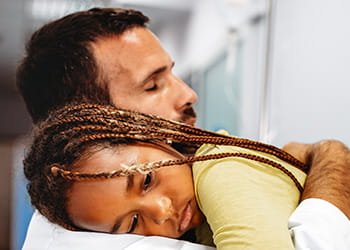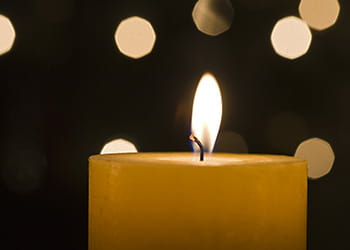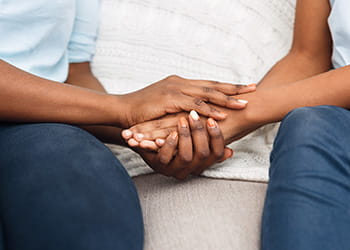What is Grief?
The death of a family member, friend or other significant person is a lifelong loss for children and can be a considered a significant event in their life. It is important to note that grief reactions in children are varied, wide-ranging, and unique to everyone. Within the same family, some individuals might experience only a few of the reactions listed, while others might struggle with many reactions. For anyone, these types of reactions are understandable and natural responses to a significant loss (see table below for age specific considerations and information). Additional examples given after table on how to talk about death, specific types of death, arrangements, etc.
Resources on Grief and Loss by Age
- Children at this stage are not able to understand the nature or permanence of death. They are likely to experience death as a separation with their special person – the person is gone, and their world is completely different.
- Caregivers might notice that all children react differently to death. Some reactions to death include seeming unaffected, have trouble sleeping/eating, searching for the person who died, have increased crying, difficulty self-soothing or being comforted, push away caregivers or clinging to strangers, separation anxiety, restlessness, irritability, or tantrums.
- As a caregiver, you can help your child by trying to maintain as much of their normal routine as possible, as well as, avoiding confusing terms for death like “resting,” “sleeping,” or “went away,” which could lead to fears of sleep or separation. Gently help your child understand that the person cannot return and that their body no longer works.
- Children at this stage typically have a limited and concrete understanding of death – thinking that the person can still breathe, needs to eat/drink or can get cold when buried. They also might engage in “magical thinking,” where they believe their wishes will come true. Sometimes they can believe that the death was their fault or punishment for being “bad.”
- Caregivers might notice that all children react differently to death. Some reactions to death may include having difficulty self-soothing/being comforted, push away caregivers or cling to strangers or seeming fine at times. Children at this stage may have frequent questions about death, retell the story repeatedly or use play to process the death. They also may seem confused or have increased fears/worries, act younger than normal, trouble sleeping/nightmares, restlessness, irritability, tantrums, and/or fear of dying. Sometimes, children exhibit physical complaints like stomachaches, headaches, trouble eating during periods of grief.
- As a caregiver, you can help your child understand death by using simple, honest explanations of death; ex. what was the cause of the death, the body stops working when you die, you cannot come back— repeating as often as the child requests. Avoid terms like “resting in peace,” or “went away” that might lead to fear of sleeping or separation. Although our initial reaction is to hide emotions from children, modeling and explaining your expressions of grief can be helpful for children, as well as utilizing outlets like art and play to allow children to express their grief.
- Children at this stage might fully understand what death means and that it is permanent and cannot return, depending on their life experiences and education. Some children believe that death is like a person or ghost who comes to get you, as well as worrying that their own thoughts/actions caused the death.
- Caregivers might notice that all children react to death differently. They may have many questions or be confused about death, initially be in denial, disbelief, shock, try to conform with peers and act like “nothing is wrong,” and/or feel guilty or remorseful for past actions with the deceased. With kids in this stage, their general distress often comes out as anger, irritability, anxiety, self-centered, fighting, or aggression to avoid feeling helpless. Reactions to grief may also come out as physical aches/pains, trouble with schoolwork or perfectionism, and/or fearing abandonment. Children might have multiple questions, be curious or fascinated with the death, and/or be confused about the death.
- As a caregiver, you can help your child understand death by offering accurate information when the child seems confused about death, model and invite expression of feelings/thoughts, provide physical outlets (sports, play), and provide reassurance of their safety and future security by offering physical proximity and comfort. Without pressuring children to talk, it can be helpful to provide a safe space to listen and answer questions honestly, but know they may be more likely to talk with peers and people outside of the family; offering peer support groups can be helpful.
- Youth at this stage typically have a full understanding of death and may have the ability to think abstractly and process spiritual issues and/or the meaning of life.
- Caregivers might notice that all youth react differently to death. They may feel guilty/remorseful for the past actions with the deceased, shame or embarrassment, sadness/tearfulness, depression, anger (at self, deceased, parents/caregivers, faith, etc.), irritability/frustration, distrust, insecure, have fear of abandonment, or even become curious/fascinated with death. Youth may attempt to act as if “nothing is wrong” around peers, engage in risky behavior/acting out and/or trouble sleeping or oversleeping.
- As a caregiver, you can help your teen through their grief by offering a safe space to listen and answer any questions without pressuring them to talk, model and invite them to express their emotions/thoughts, encourage journaling/drawing/other expressive outlets; however, know many teens may be more likely to talk with peers and people outside of family – peer support groups can be helpful. Additionally, it is helpful avoid putting adult responsibilities or pressure on teens and give them time to process.
Explaining Dying, Death, and Dead:
- Use simple, honest words and phrases. Avoid confusing phrases like “passed away” or “went to sleep.” Instead use concrete, simple explanations to avoid the fear of sleeping.
- Everything that lives dies at some time. Plants die, animals die, and people die. Death is a natural part of life.
- When a person dies, their body stops working their brain can’t send or receive messages, their heart stops beating, their lungs stop working, and their body cannot feel or move.
- It’s important to remember that words or thoughts never cause someone to die.
- A dead person might look like they are sleeping, but they are not sleeping and will not wake up.
- When a person dies, they cannot come back to life.
- When speaking about faith/religious beliefs, it is important to make sure they understand how concrete death is. Using phrases like “went to heaven/next life/paradise/rainbow bridge/moved on to a better place,” “no longer in pain,” “watch over you/guardian angel” can confuse children – they might ask to visit heaven/paradise/better place, ask why they did not get medicine for pain to help, or why they can’t see their angel looking at them.
Explaining Specific Types of Death:
Cancer: A person’s body is made up of cells. Cancer is when the cells don’t grow right, and they make the body sick. Sometimes cancer causes a bump, or lump to grow, and sometimes cancer can make the blood, bones, or other parts of the body so sick that the body stops working.
Heart attack: A person’s heart is the engine that movies the blood through their body. When the heart stops working, it can’t move the blood through their body.
Kidney or Liver Failure: The kidneys and liver help clean the blood in the body. If a person’s kidneys stop working, the blood gets dirty and makes their body get sick.
Suicide: When there’s a sickness in a person’s brain (e.g., depression, addiction, mental illness), the sickness can make the person feel so sad and lonely that they do not want to live anymore. When they feel this way, some people decide to do something to make their own body stop working.
Trauma: When there is a big accident that causes a person to have many injuries. Sometimes they can hurt their brain, (which is like the computer for their body and tells our heart to beat, eyes to blink, mouth to talk, lungs to breathe, legs to walk, etc.) but when their brain is hurt/sick the brain does not tell their body to do those things and “turns off.”
End of Life Arrangements:
Funeral/Wake/Celebration of Life/Memorial Service: Ceremony that is held because someone has died. Friends and family gather to feel/show sadness, celebrate and/or give thanks for the life the person had that has died.
Burial: The act of placing a dead body or object (cremation remains) into the ground. The dead body/object is put into a coffin/casket (a box used to keep dead bodies) and placed into the ground, or a grave. The grave is usually marked with a headstone so people know who is there and can visit.
Cremation: Their body is no longer attached to the physical body (think about old clothes that we discard as we put on new ones). unique process with lots of heat that turns the body into small pieces that look and feel like sand. But, it’s not like the sand at the beach. It’s different, even though it looks the same. There are no dead bodies in the sand at the beach. When a person dies, they no longer feel anything. The cremation process doesn’t hurt because the body is no longer alive and cannot feel pain.






